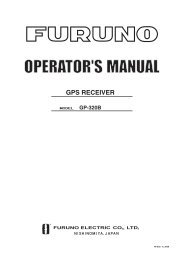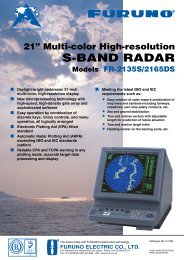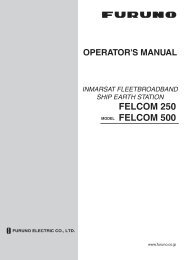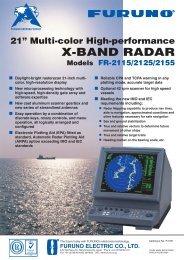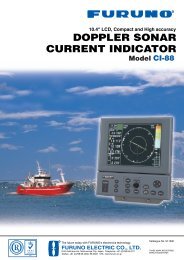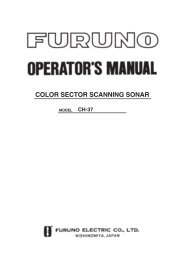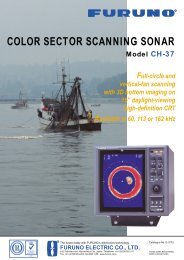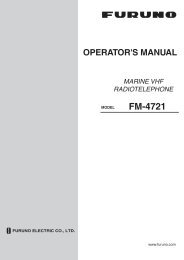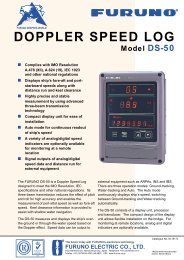- Page 1: OPERATOR'S MANUAL SSB RADIOTELEPHON
- Page 4 and 5: ii SAFETY INSTRUCTIONS The user and
- Page 6 and 7: DISTRESS ALERT MESSAGE PROCEDURE Be
- Page 8 and 9: CANCELLING DISTRESS ALERT 4. Commun
- Page 10 and 11: TABLE OF CONTENTS viii 3.4.2 Send c
- Page 12 and 13: TABLE OF CONTENTS x 8.3.2 Editing/D
- Page 14 and 15: FOREWORD Thank you for purchasing t
- Page 16 and 17: SYSTEM CONFIGURATIONS FS-1570 Stand
- Page 18 and 19: SYSTEM CONFIGURATIONS FS-5070 Stand
- Page 20 and 21: 1. OPERATIONAL OVERVIEW 7/ key Turn
- Page 22 and 23: 1. OPERATIONAL OVERVIEW 1.5 Control
- Page 24 and 25: 1. OPERATIONAL OVERVIEW • The oth
- Page 26 and 27: 2. SSB RADIOTELEPHONE . C n C anne
- Page 28 and 29: 2. SSB RADIOTELEPHONE completed, TU
- Page 30 and 31: 2. SSB RADIOTELEPHONE .4.3 ece n A
- Page 32 and 33: 2. SSB RADIOTELEPHONE 2.6 User Chan
- Page 34 and 35: 3. DSC OVERVIEW Contents of a DSC c
- Page 36 and 37: 3. DSC OVERVIEW 3.4 nter ret n Ca D
- Page 40 and 41: 4. DISTRESS OPERATIONS 4.1.1 Send n
- Page 42 and 43: 4. DISTRESS OPERATIONS 4.1. Send n
- Page 44 and 45: 4. DISTRESS OPERATIONS 4-6 The disp
- Page 46 and 47: 4. DISTRESS OPERATIONS Action for s
- Page 48 and 49: 4. DISTRESS OPERATIONS 5. Rotate th
- Page 50 and 51: 4. DISTRESS OPERATIONS Sending the
- Page 52 and 53: 4. DISTRESS OPERATIONS 4.3 Send n D
- Page 54 and 55: 4. DISTRESS OPERATIONS 12. Enter po
- Page 56 and 57: 4. DISTRESS OPERATIONS 4.3. Send n
- Page 58 and 59: . DISTRESS OPERATIONS 1 . Push the
- Page 60 and 61: 4. DISTRESS OPERATIONS 2. Choose CA
- Page 62 and 63: 5. ROUTINE MESSAGE CALLING, RECEVIN
- Page 64 and 65: 5. ROUTINE MESSAGE CALLING, RECEVIN
- Page 66 and 67: 5. ROUTINE MESSAGE CALLING, RECEVIN
- Page 68 and 69: 5. ROUTINE MESSAGE CALLING, RECEVIN
- Page 70 and 71: 5. ROUTINE MESSAGE CALLING, RECEVIN
- Page 72 and 73: 5. ROUTINE MESSAGE CALLING, RECEVIN
- Page 74 and 75: 5. ROUTINE MESSAGE CALLING, RECEVIN
- Page 76 and 77: 5. ROUTINE MESSAGE CALLING, RECEVIN
- Page 78 and 79: 5. ROUTINE MESSAGE CALLING, RECEVIN
- Page 80 and 81: 5. ROUTINE MESSAGE CALLING, RECEVIN
- Page 82 and 83: 5. ROUTINE MESSAGE CALLING, RECEVIN
- Page 84 and 85: 5. ROUTINE MESSAGE CALLING, RECEVIN
- Page 86 and 87: 5. ROUTINE MESSAGE CALLING, RECEVIN
- Page 88 and 89:
5. ROUTINE MESSAGE CALLING, RECEVIN
- Page 90 and 91:
5. ROUTINE MESSAGE CALLING, RECEVIN
- Page 92 and 93:
5. ROUTINE MESSAGE CALLING, RECEVIN
- Page 94 and 95:
5. ROUTINE MESSAGE CALLING, RECEVIN
- Page 96 and 97:
5. ROUTINE MESSAGE CALLING, RECEVIN
- Page 98 and 99:
5. ROUTINE MESSAGE CALLING, RECEVIN
- Page 100 and 101:
6. MENU OPERATION 6. N e an er The
- Page 102 and 103:
6. MENU OPERATION 6.4. De et n er c
- Page 104 and 105:
6. MENU OPERATION 1 . Rotate the N
- Page 106 and 107:
6. MENU OPERATION . Push the N knob
- Page 108 and 109:
6. MENU OPERATION 11. Rotate the N
- Page 110 and 111:
6. MENU OPERATION De et n a e a e 1
- Page 112 and 113:
6. MENU OPERATION 6. Date and e Set
- Page 114 and 115:
6. MENU OPERATION C ear n e a e e 1
- Page 116 and 117:
6. MENU OPERATION 6.11 Sett n t e A
- Page 118 and 119:
6. MENU OPERATION 6.13 Sett n Scan
- Page 120 and 121:
6. MENU OPERATION 6.14 ey A n ent T
- Page 122 and 123:
6. MENU OPERATION This page is inte
- Page 124 and 125:
7. NBDP S STEM OVERVIEW . De cr t n
- Page 126 and 127:
7. NBDP S STEM OVERVIEW .3 nct n ey
- Page 128 and 129:
7. NBDP S STEM OVERVIEW .3.3 nct n
- Page 130 and 131:
7. NBDP SYSTEM OVERVIEW Function ke
- Page 132 and 133:
7. NBDP SYSTEM OVERVIEW Function ke
- Page 134 and 135:
7. NBDP SYSTEM OVERVIEW Window Colo
- Page 136 and 137:
8. NBDP PREPARATIONS 8-2 For final
- Page 138 and 139:
8. NBDP PREPARATIONS 8. If you sele
- Page 140 and 141:
8. NBDP PREPARATIONS 8.3.2 Editing/
- Page 142 and 143:
. NBDP PREPARATIONS new ones. If th
- Page 144 and 145:
9. NBDP FILE OPERATIONS Note: Do no
- Page 146 and 147:
9. NBDP FILE OPERATIONS Cutting tex
- Page 148 and 149:
9. NBDP FILE OPERATIONS 9.4.5 Repla
- Page 150 and 151:
9. NBDP FILE OPERATIONS 4. Enter a
- Page 152 and 153:
10. NBDP TRANSMITTING, RECEIVING 5.
- Page 154 and 155:
10. NBDP TRANSMITTING, RECEIVING No
- Page 156 and 157:
10. NBDP TRANSMITTING, RECEIVING 10
- Page 158 and 159:
10. NBDP TRANSMITTING, RECEIVING Co
- Page 160 and 161:
10. NBDP TRANSMITTING, RECEIVING 10
- Page 162 and 163:
10. NBDP TRANSMITTING, RECEIVING 10
- Page 164 and 165:
10. NBDP TRANSMITTING, RECEIVING Pr
- Page 166 and 167:
10. NBDP TRANSMITTING, RECEIVING 10
- Page 168 and 169:
10. NBDP TRANSMITTING, RECEIVING 10
- Page 170 and 171:
11. MAINTENANCE & TROUBLESHOOTING 1
- Page 172 and 173:
11. MAINTENANCE TROUBLESHOOTING 11.
- Page 174 and 175:
11. MAINTENANCE TROUBLESHOOTING 11.
- Page 176 and 177:
11. MAINTENANCE TROUBLESHOOTING MAR
- Page 178 and 179:
11. MAINTENANCE TROUBLESHOOTING con
- Page 180 and 181:
APPENDIX N D ter na n t te e Defaul
- Page 182 and 183:
APPENDIX Custom channels (to be pro
- Page 184 and 185:
APPENDIX MF band SSB working carrie
- Page 186 and 187:
APPENDIX 8 MH ITU SSB carrier frequ
- Page 188 and 189:
APPENDIX 18/19, 22, 25/26 ITU SSB c
- Page 190 and 191:
APPENDIX AP-12 ITU Telex frequency
- Page 192 and 193:
APPENDIX AP-14 ITU Telex frequency
- Page 194 and 195:
APPENDIX AP-16 Telex Abbreviations
- Page 196 and 197:
APPENDIX GLL Geographic position la
- Page 198 and 199:
APPENDIX RMC Recommended minimum sp
- Page 200 and 201:
APPENDIX art t This equipment conta
- Page 202 and 203:
APPENDIX Control unit FS-2571C F U
- Page 204 and 205:
APPENDIX Parts Location FS-1570T 05
- Page 206 and 207:
APPENDIX Transceiver unit FS-5070T
- Page 208 and 209:
APPENDIX C ntr n t S- 1C A -3 05P08
- Page 210 and 211:
FURUNO FS-1570/2570/5070 1. . Sensi
- Page 212 and 213:
FURUNO FS-1570/2570/5070 -60 dB: wi
- Page 214 and 215:
FURUNO FS-1570/2570/5070 . Degree o
- Page 216 and 217:
Print out menu ....................
- Page 218 and 219:
Declaration of Conformity 9-52 Ashi




